1993 BUICK PARK AVENUE engine overheat
[x] Cancel search: engine overheatPage 11 of 340
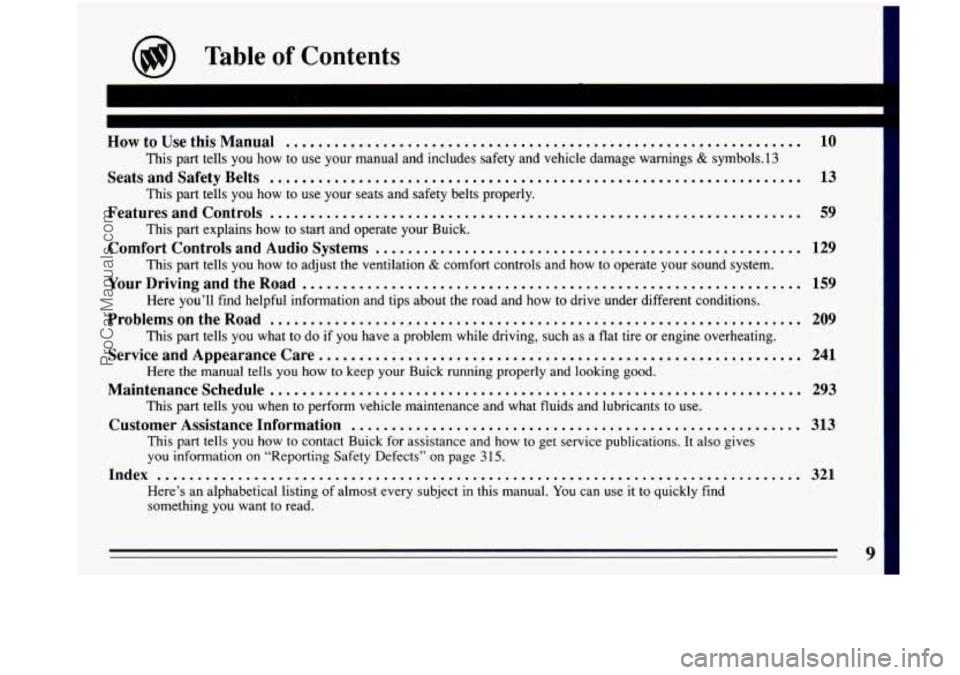
@ Table of Contents
HowtoUsethisManual ................................................................ 10 1
This part tells you how to use your manual and includes safety and vehicle damage warnings & symbols. 13
This part tells you how to use your seats and safety belts properly.
This part explains how to start and operate your Buick.
This part tells you how to adjust the ventilation
& comfort controls and how to operate your sound system.
Here you’ll find helpful information and tips about the road and how to drive under different conditions.
This part tells you what to do if you have a problem
while driving, such as a flat tire or engine overheating.
Here the manual tells you how to keep your Buick running properly and looking good.
This part tells you when to perform vehicle maintenance and what fluids and lubricants to use.
This part tells you how to contact Buick for assistance and how to get service publications. It also gives
you information on “Reporting Safety Defects” on page 315.
Here’s an alphabetical listing of almost every subject in this manual.
You can use it to quickly find
something you want to read.
SeatsandSafetyBelts .................................................................. 13
FeaturesandControls
.................................................................. 59
Comfort Controls and Audio Systems
..................................................... 129
YourDrivingandtheRoad
.............................................................. 159
ProblemsontheRoad
.................................................................. 209
Service and Appearance Care..
.......................................................... 241
Maintenanceschedule
.................................................................. 293
Customer Assistance Information
........................................................ 313
Index
........................................................................\
........ 321
ProCarManuals.com
Page 82 of 340
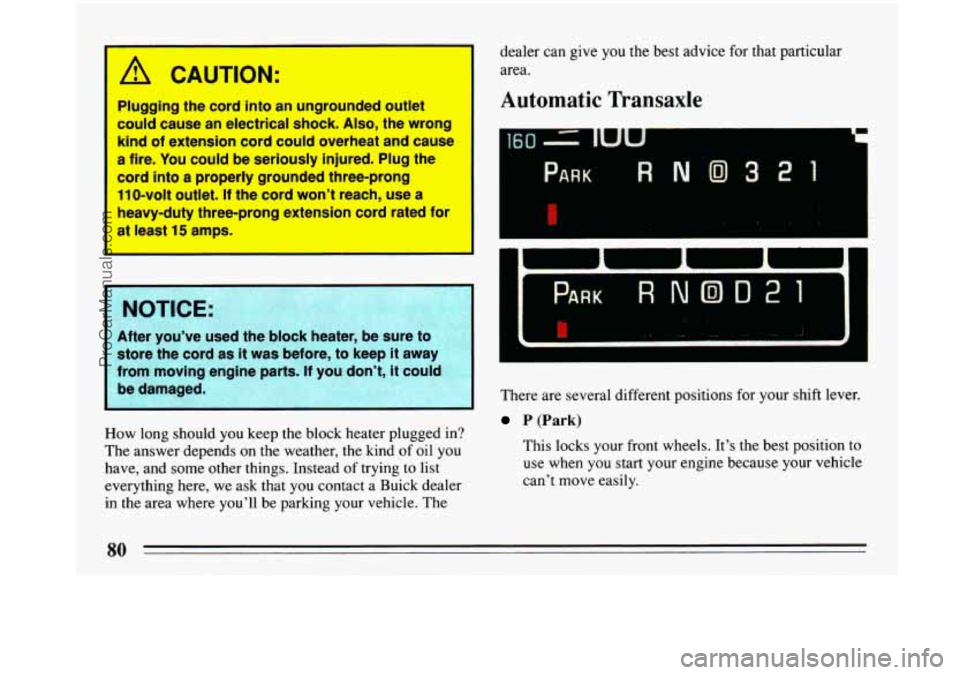
A CAUTION:
I
Plugging the cord into an ungrounded outlet
could cause an electrical shock.
Also, the wrong
kind of extension cord could overheat and cause
a fire. You could be seriously injured. Plug the
cord into a properly grounded three-prong
110-volt outlet. If the cord won’t reach, use
a
heavy-duty three-prong extension cord rated for
at least
15 amps.
I
I NOTICE:
After you’ve used the block heater, be sure to
store the cord as
it was before, to keep it away
from moving engine parts. If you
don’t, it could
be damaged.
1
I
How long should you keep the block heater plugged in?
The answer depends on the weather, the kind
of oil you
have, and some other things. Instead
of trying to list
everything here, we ask that
you contact a Buick dealer
in the area where you’ll be parking your vehicle. The dealer
can give you the
best advice for that particular
area.
Automatic Transaxle
160 - IULJ
PARK FINO321
i
b
PARK R N 0 D 2 1
There are several different positions for your shift lever.
P (Park)
This locks your front wheels. It’s the best position to
use when you start your engine because your vehicle
can’t move easily.
I
80
ProCarManuals.com
Page 87 of 340
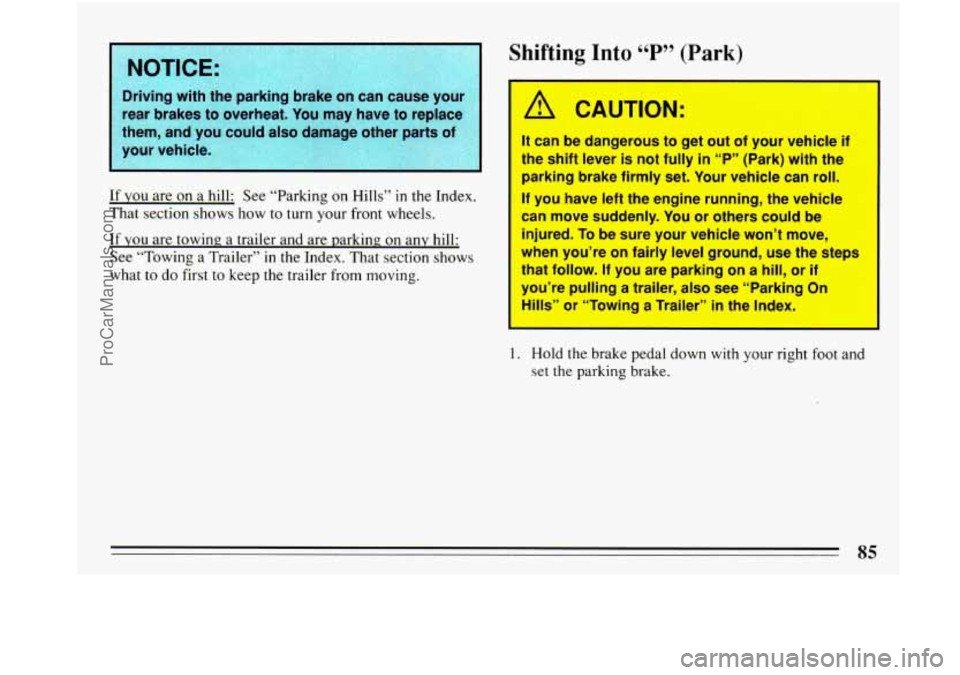
Driving with the parking brake on can cause youkz.,--.I
rear brakes to overheat.
You may have to replace-
them, and you could also damage other parts of
If YOU are on a hill: See “Parking on Hills” in the Index.
That section shows how to turn your front wheels.
If you are towing a trailer and are parking on any hill:
See “Towing a Trailer”
in the Index. That section shows
what
to do first to keep the trailer from moving.
Shifting Into “P” (Park)
A CAUTION:
It can be dangerous to get out of your vehicle if
the shift lever is not fully in “P” (Park) with the
parking brake firmly set. Your vehicle can roll.
If you have left the engine running, the vehicle
can move suddenly. You or others could be
injured. To be sure your vehicle won’t move,
when you’re on fairly level ground, use the steps
that follow.
If you are parking on a hill, or if
you’re pulling a trailer, also see “Parking On
H”‘ ;” or “Towing a Trailer” in the Index.
1. Hold the brake pedal down with your right foot and
set
the parking brake.
ProCarManuals.com
Page 89 of 340
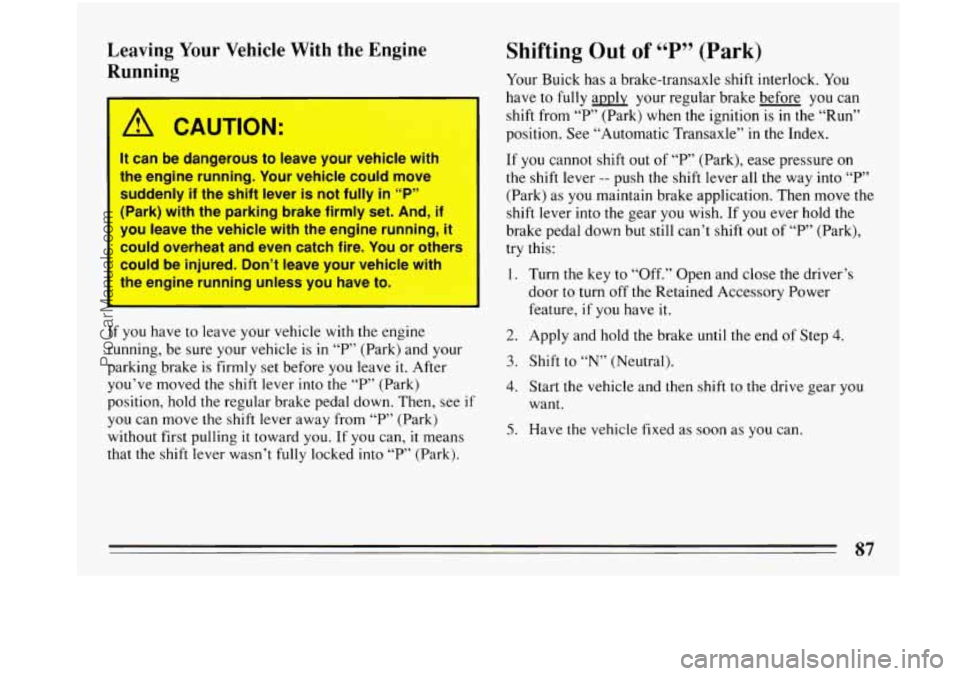
Leaving Your Vehicle With the Engine
Running
I
A CAUTION:
It can be dangerous to leave your vehicle with
the engine running. Your vehicle could move
suddenly
if the shift lever is not fully in “P”
(Park) with the parking brake firmly set. And, if
you leave the vehicle with the engine running,
it
could overheat and even catch fire. You or other3
could be injured. Don’t leave your vehicle with
the engine running unless you have to.
If you have to leave your vehicle with the engine
running, be sure your vehicle is in “P” (Park) and your
parking brake is firmly
set before you leave it. After
you’ve moved the shift lever
into the “P” (Park)
position, hold the regular brake pedal down. Then, see if
you can move the shift lever away from “P” (Park)
without first pulling it toward you. If you can, it means
that the shift lever wasn’t fully locked into “P” (Park).
Shifting Out of 46 P $9 (Park)
Your Buick has a brake-transaxle shift interlock. You
have
to fully apply your regular brake before you can
shift from “P” (Park) when the ignition is in the “Run”
position. See “Automatic Transaxle” in the Index.
If you cannot shift out of
“P” (Park), ease pressure on
the shift lever
-- push the shift lever all the way into “P’
(Park) as you maintain brake application. Then move the
shift lever into the gear
you wish. If you ever hold the
brake pedal down but still can’t shift out of “P” (Park),
try this:
I. Turn the key to “Off.” Open and close the driver’s
door to turn off the Retained Accessory Power
feature,
if you have it.
2. Apply and hold the brake until the end of Step 4.
3. Shift to “N” (Neutral).
4. Start the vehicle and then shift to the drive gear you
want.
5. Have the vehicle fixed as soon as you can.
87
ProCarManuals.com
Page 123 of 340
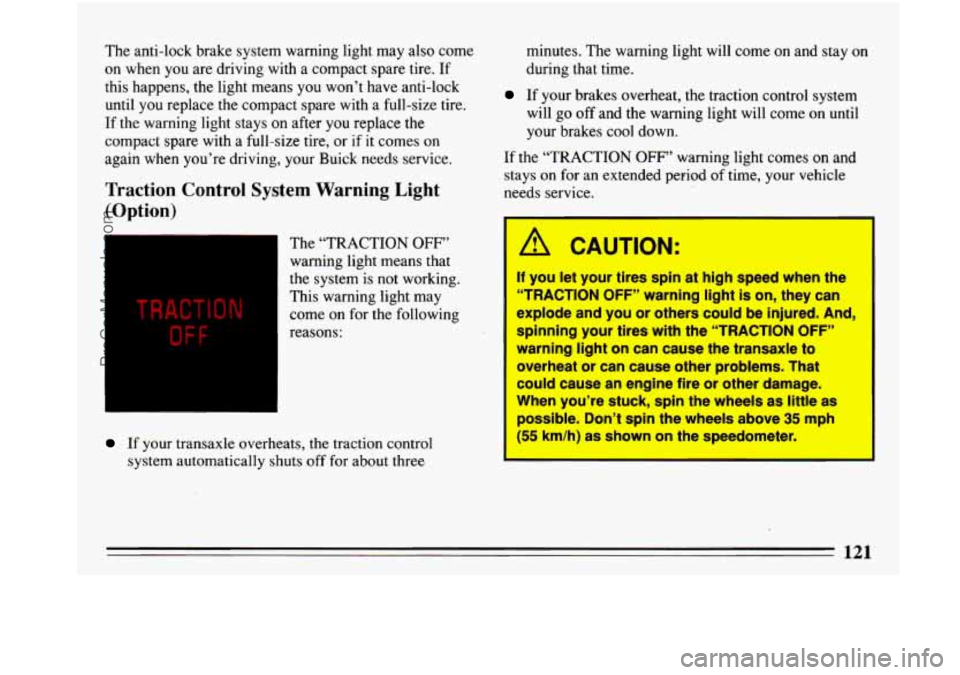
The anti-lock brake system warning light may also come
on when you are driving with a compact spare tire. If
this happens, the light means you won’t have anti-lock
until you replace the compact spare with a full-size tire.
If the warning light stays on after you replace the
compact spare
with a full-size tire, or if it comes on
again when
you’re driving, your Buick needs service.
Traction Control System Warning Light
(Option)
I The “TRACTION OFF”
warning light means that
the system is not working.
This warning light may
come on for the following
reasons:
If your transaxle overheats, the traction control
system automatically shuts off for about three minutes.
The warning light will come on and stay on
during that time.
If your brakes overheat, the traction control system
will
go off and the warning light will come on until
your brakes cool down.
If the “TRACTION OFF” warning light comes on and
stays on
for an extended period of time, your vehicle
needs service.
A CAUTION:
1 If you let your tires spin at high speed when the
“TRACTION
OFF” warning light is on, they can
explode and you or others could be injured. And,
spinning your tires with the “TRACTION
OFF”
warning light on can cause the transaxle to
overheat or can cause other problems. That
could cause an engine fire or other damage.
When you’re stuck, spin the wheels as little as
possible. Don’t spin the wheels above
35 mph
(55 km/h) as shown on the speedometer.
I
121
ProCarManuals.com
Page 124 of 340
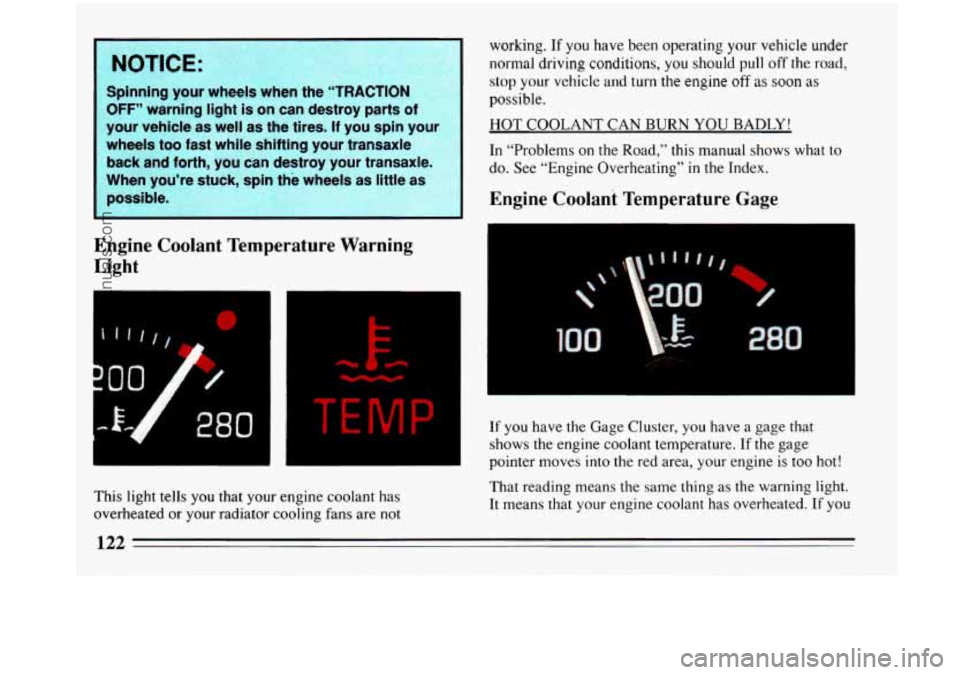
I NOTICE:
Spinning your wheels when the “TRACTION
OFF” warning light is on can destroy parts of
your vehicle as well as the tires.
If you spin your
wheels too fast while shifting your transaxle
back and forth, you can destroy your transaxle.
When you’re stuck, spin the wheels
as little as
possible.
~~~~~~
1
working. If you have been operating your vehicle under
normal driving conditions,
you should pull off the road,
Engine Coolant Temperature Warning
Light
7
280
stop your vehicle and turn the engine off as soon as
possible.
HOT COOLANT CAN BURN YOU BADLY!
In “Problems
on the Road,” this manual shows what to
do. See “Engine Overheating”
in the Index.
Engine Coolant Temperature Gage
100
.Id pointer moves into the red area, your engine is too hot!
If you have the Gage Cluster, you have a gage that
shows the engine coolant temperature.
If the gage
This light
tells you that your engine coolant has
overheated or your radiator cooling fans are
not
That reading means the same thing as the warning light.
It means that your engine coolant has overheated.
If you
122
ProCarManuals.com
Page 125 of 340
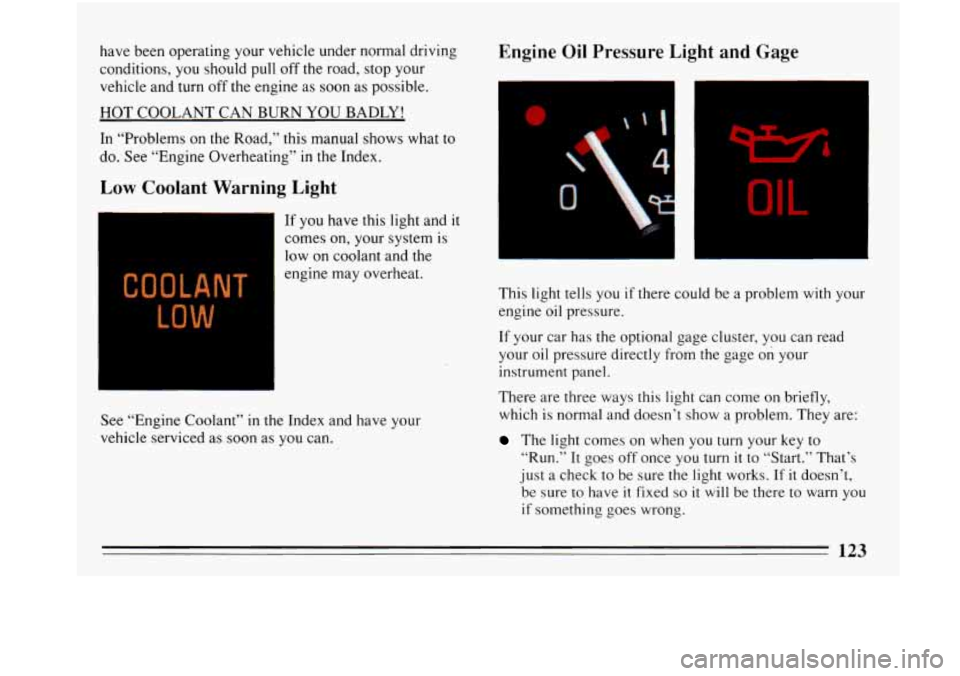
have been operating your vehicle under normal driving
conditions,
you should pull off the road, stop your
vehicle and turn off the engine as soon as possible.
HOT COOLANT CAN BURN YOU BADLY!
In “Problems
on the Road,” this manual shows what to
do. See “Engine Overheating”
in the Index.
Low Coolant Warning Light
I
1
If you have this light and it
comes on, your system
is
low on coolant and the
engine may overheat.
See “Engine Coolant” in the Index and have your
vehicle serviced as soon as you can.
Engine Oil Pressure Light and Gage
0‘ 1
I
This light tells you if there could be a problem with your
engine oil pressure.
If your car has the optional gage cluster, you can read
your oil pressure directly from the gage
on your
instrument panel.
There are three ways this light can come on briefly,
which
is normal and doesn’t show a problem. They are:
The light comes on when you turn your key to
“Run.” It goes off once you turn
it to “Start.” That’s
just a check to be sure the light works. If it doesn’t,
be sure to have it fixed so it will be there to warn you
if something goes wrong.
123
ProCarManuals.com
Page 174 of 340
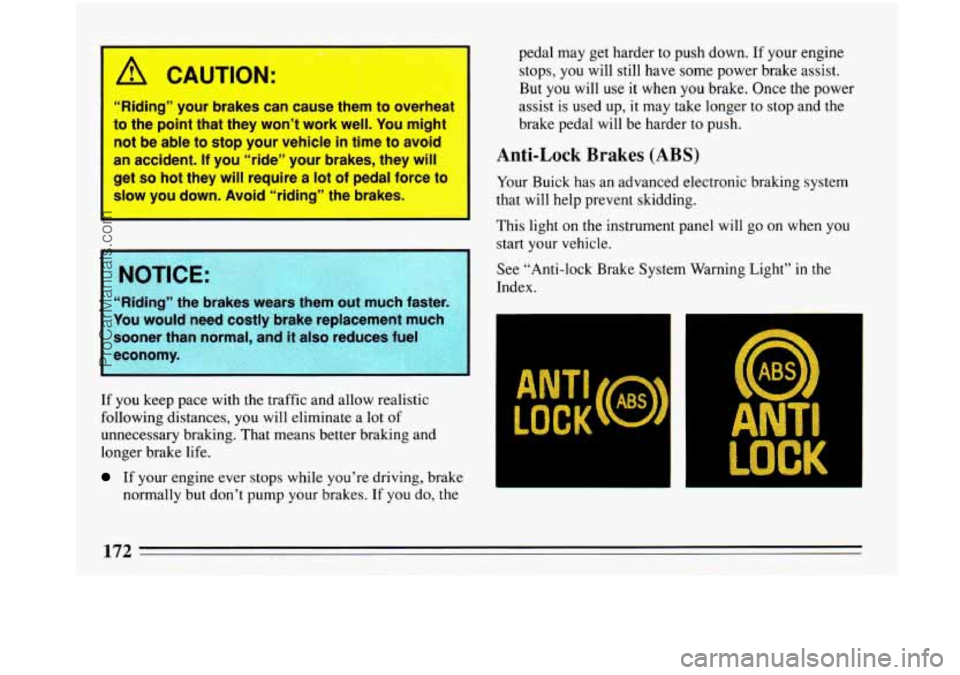
---
1 A CAUTION:
“Riding” your brakes can cause them to overheat
to the point
that they won’t work well. You might
not be able to stop your vehicle
in time to avoid
an accident.
If you “ride” your brakes, they will I
get so hot they will require a lot of pedal force to
slow you down. Avoid “riding” the brakes.
‘I
E:
e brakes weafs them out much faster
You would need costly brake replacement much
sooner than normal, and
it also reduces fuel
If you keep pace with the traffic and allow realistic
following distances,
you will eliminate a lot of
unnecessary braking. That means better braking and
longer brake life.
If your engine ever stops while you’re driving, brake
normally but don’t pump your brakes. If
you do, the pedal
may get harder to push down.
If your engine
stops,
you will still have some power brake assist.
But you will use it when you brake. Once the power
assist is used up, it may take longer to stop and the
brake pedal will be harder to push.
Anti-Lock Brakes (ABS)
Your Buick has an advanced electronic braking system
that will help prevent skidding.
This light on the instrument panel will
go on when you
start your vehicle.
See “Anti-lock Brake System Warning Light” in the
Index.
ANTI
LOCK ANTI
LOCK
ProCarManuals.com